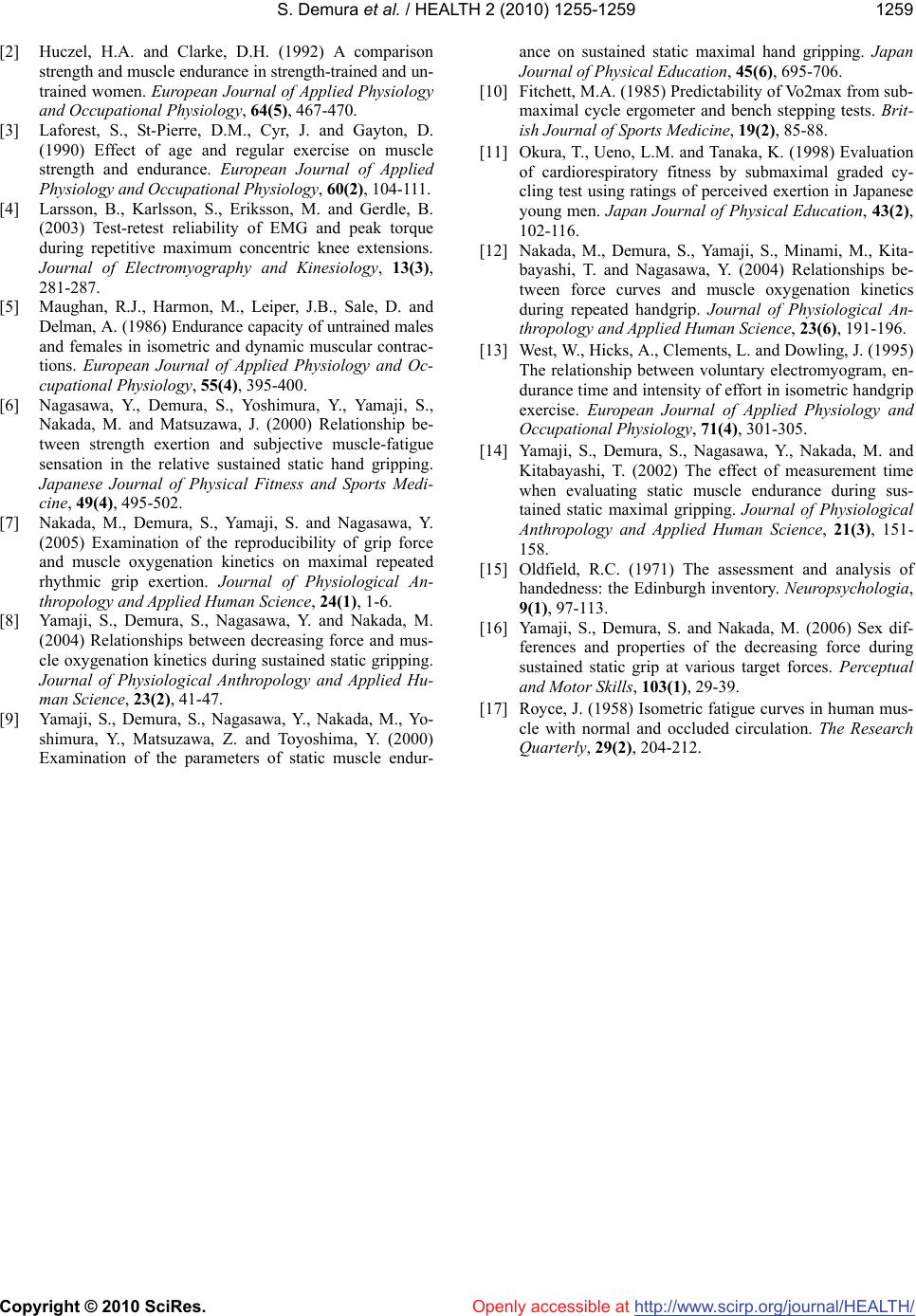
S. Demura et al. / HEALTH 2 (2010) 1255-1259
Copyright © 2010 SciRes. http://www.scirp.org/journal/HEALTH/Openly accessible at
1259
[2] Huczel, H.A. and Clarke, D.H. (1992) A comparison
strength and muscle endurance in strength-trained and un-
trained women. European Journal of Applied Physiology
and Occupational Physiology, 64(5), 467-470.
[3] Laforest, S., St-Pierre, D.M., Cyr, J. and Gayton, D.
(1990) Effect of age and regular exercise on muscle
strength and endurance. European Journal of Applied
Physiology and Occupational Physiology, 60(2), 104-111.
[4] Larsson, B., Karlsson, S., Eriksson, M. and Gerdle, B.
(2003) Test-retest reliability of EMG and peak torque
during repetitive maximum concentric knee extensions.
Journal of Electromyography and Kinesiology, 13(3),
281-287.
[5] Maughan, R.J., Harmon, M., Leiper, J.B., Sale, D. and
Delman, A. (1986) Endurance capacity of untrained males
and females in isometric and dynamic muscular contrac-
tions. European Journal of Applied Physiology and Oc-
cupational Physiology, 55(4), 395-400.
[6] Nagasawa, Y., Demura, S., Yoshimura, Y., Yamaji, S.,
Nakada, M. and Matsuzawa, J. (2000) Relationship be-
tween strength exertion and subjective muscle-fatigue
sensation in the relative sustained static hand gripping.
Japanese Journal of Physical Fitness and Sports Medi-
cine, 49(4), 495-502.
[7] Nakada, M., Demura, S., Yamaji, S. and Nagasawa, Y.
(2005) Examination of the reproducibility of grip force
and muscle oxygenation kinetics on maximal repeated
rhythmic grip exertion. Journal of Physiological An-
thropology and Applied Human Science, 24(1), 1-6.
[8] Yamaji, S., Demura, S., Nagasawa, Y. and Nakada, M.
(2004) Relationships between decreasing force and mus-
cle oxygenation kinetics during sustained static gripping.
Journal of Physiological Anthropology and Applied Hu-
man Science, 23(2), 41-47.
[9] Yamaji, S., Demura, S., Nagasawa, Y., Nakada, M., Yo-
shimura, Y., Matsuzawa, Z. and Toyoshima, Y. (2000)
Examination of the parameters of static muscle endur-
ance on sustained static maximal hand gripping. Japan
Journal of Physical Education, 45(6), 695-706.
[10] Fitchett, M.A. (1985) Predictability of Vo2max from sub-
maximal cycle ergometer and bench stepping tests. Brit-
ish Journal of Sports Medicine, 19(2), 85-88.
[11] Okura, T., Ueno, L.M. and Tanaka, K. (1998) Evaluation
of cardiorespiratory fitness by submaximal graded cy-
cling test using ratings of perceived exertion in Japanese
young men. Japan Journal of Physical Education, 43(2),
102-116.
[12] Nakada, M., Demura, S., Yamaji, S., Minami, M., Kita-
bayashi, T. and Nagasawa, Y. (2004) Relationships be-
tween force curves and muscle oxygenation kinetics
during repeated handgrip. Journal of Physiological An-
thropology and Applied Human Science, 23(6), 191-196.
[13] West, W., Hicks, A., Clements, L. and Dowling, J. (1995)
The relationship between voluntary electromyogram, en-
durance time and intensity of effort in isometric handgrip
exercise. European Journal of Applied Physiology and
Occupational Physiology, 71(4), 301-305.
[14] Yamaji, S., Demura, S., Nagasawa, Y., Nakada, M. and
Kitabayashi, T. (2002) The effect of measurement time
when evaluating static muscle endurance during sus-
tained static maximal gripping. Journal of Physiological
Anthropology and Applied Human Science, 21(3), 151-
158.
[15] Oldfield, R.C. (1971) The assessment and analysis of
handedness: the Edinburgh inventory. Neuropsychologia,
9(1), 97-113.
[16] Yamaji, S., Demura, S. and Nakada, M. (2006) Sex dif-
ferences and properties of the decreasing force during
sustained static grip at various target forces. Perceptual
and Motor Skills, 103(1), 29-39.
[17] Royce, J. (1958) Isometric fatigue curves in human mus-
cle with normal and occluded circulation. The Research
Quarterly, 29(2), 204-212.